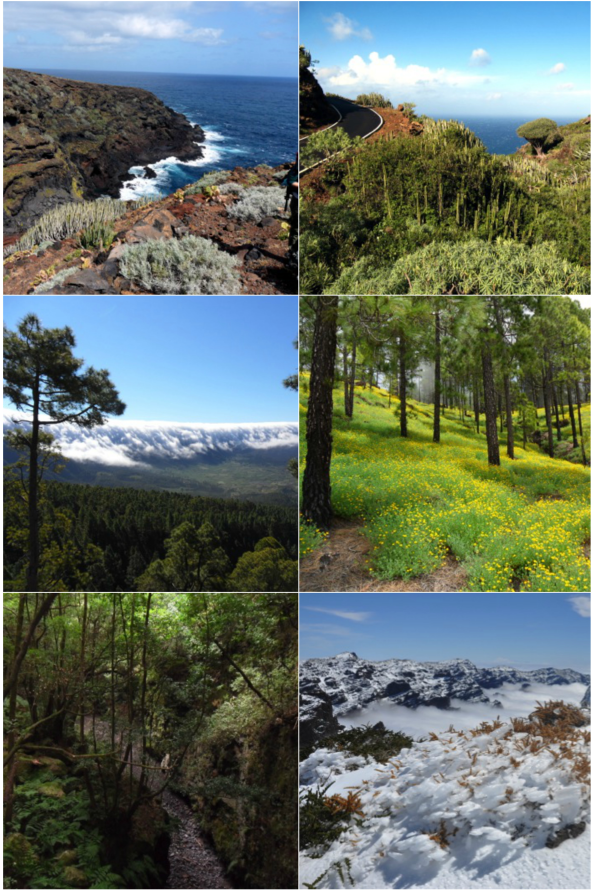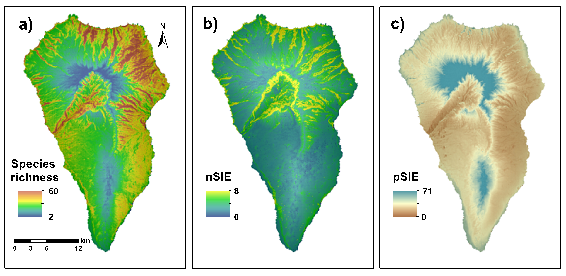It is our pleasure to announce that Journal of Ecology author Severin Irl (University of Bayreuth) has been awarded the Eduard Strasburger Award for his 2015 paper; Climate vs. topography – spatial patterns of plant species diversity and endemism on a high-elevation island. The prize is awarded every 2 years by the German Botanical Society and Springer Spektrum to a young researcher for outstanding work in the field of botany. Severin Irl tells us more about his winning paper below…
When it comes to subtropical islands, are you thinking of white sandy beaches and rolling green hills? Sorry, but you’ve got it all wrong when it comes to this one! La Palma of the Canary Islands is a volcanic island featuring black sand beaches and dramatic 100m cliffs. Due to its relative youth and the specific lava types, the island is actually considered the steepest island in the world, reaching almost 2500m above sea level but only measuring around 700 km2.
The Canary Islands are influenced by trade winds (easterly surface winds) all year round, with visitors able to experience summer at the coast, a snowy winter at the summits, humid evergreen laurel forest in the northeast to arid desert-like scrub in the west within a single day (if you can handle the curvy roads, of course).

Figure 1: La Palma harbours a wide range of different ecosystems, each containing a specific species set. All pictures taken by Severin Irl, except for the top right one (Philipp Gnoyke) and the bottom right one (Ángel Palomares Martínez).
For the main theme of our paper, we tried to tackle one of the most fundamental questions in ecology: what drives the spatial pattern of plant diversity and endemism? Is it climate, is it topography, or is it both?
Besides harbouring a wide range of different endemic species, the island of La Palma is of a very heterogeneous nature regarding its environmental settings. By collecting almost 900 vegetation plots and covering the whole island, we were able to take advantage of the interesting setting of the island.
So, what’s more important for plant diversity and endemism? As so often in life, it depends! Endemic richness is mainly driven by topography, whereas climate hardly has any effect on its spatial pattern. We argue that two (non-exclusive) topography-driven processes are behind the pattern of endemic richness.
Whereas evolutionary processes such as an increase in available niche space, micro-refugia during periods of climatic fluctuations, or a pre-adaptation of endemic species to rupicolous conditions, drive the basic spatial pattern, human presence has impacted this pattern as well, e.g. introduced herbivores, fire and land use (which are all major threats to island biodiversity, Caujapé-Castells et al. 2010), and is likely superimposed onto the evolutionary pattern.
However, while topography mainly drives endemic richness, interestingly, climate is most important for endemicity, which might be a result of speciation driven by climatic selective adaptation pressures (Steinbauer et al. 2016). As a result, we find incongruent hotspots of endemic richness and endemicity throughout the island (Fig. 2), which could have major implications for conservation planning and management and might also be of general importance for other regions of the world.

Figure 2: Interpolated maps of a) species richness, b) endemic richness (measured as the number of single-island endemics), and c) endemicity (measured as the percentage of single-island endemics). Hotspots of species richness are found in the valleys on the windward side, while hotspots of endemic richness are exclusively restricted to steep valleys and the inner cliffs of the Caldera de Taburiente complex. Hotspots of endemicity are found at the highest elevations (where species richness and endemic richness are lowest).
The unexpected importance of topography in explaining endemic richness might have consequences for species distribution modeling where often only climate is considered. This might also be the case for climatic variability indices, such as rainfall seasonality or inter-annual and intra-annual precipitation variability, because climate change is predicted to have a major impact on island systems (Harter et al. 2015).
We show that these measures of variability are important in explaining species richness as well as endemicity on La Palma. In general, high-elevation islands such as the so-called isla bonita are highly suitable to study drivers of diversity and endemism, as they offer environmental gradients of continental magnitude on the landscape scale of a single climatic mini-continent and a large array of endemics.
Follow-up research: Rarity and climate change
We were interested in why rare endemic species congregate in certain areas on La Palma and which environmental drivers were behind these hot spots of endemic rarity. Also, we wanted to know how current protected areas were able to adequately protect hot spots of endemic rarity. We find that rare endemics are particularly found at high elevations, likely as a result of harsh environmental conditions, increased isolation and small area. In addition to this, existing protected areas on La Palma are able to protect rare endemics quite well. Actually, the stricter a protected area, the better it protects hot spots of endemic rarity! These results were recently published in Diversity and Distributions (Irl et al. 2017).
However, environmental conditions are likely to change during ongoing climate change, so that areas that offer adequate protection now might not be able to do so in the future. In fact, even endemics on oceanic islands, which are generally famed for their stable climate, will be affected by climatic changes (Harter et al. 2015).
Currently, we are looking into possible effects of climate change on the distribution of diversity and endemism using species distribution models and local small-scale climate change scenarios. As a result of their distribution within a single island, endemic species cannot migrate to other landmasses. They can only deal with what is offered by their home island which naturally makes them vulnerable to climatic changes.
First results show that high elevation endemics are particularly endangered as they cannot shift further upwards and temperature increases are highest at high elevations. These are important insights into possible changes as islands cover only 3% of the global surface but harbour around 25% of global biodiversity meaning climatic changes could lead to disproportional extinctions within island systems.
Severin D.H. Irl (University of Bayreuth, Germany)
For more information on the Eduard Strasburger Award see here (German only). And read the full paper here; Climate vs. topography – spatial patterns of plant species diversity and endemism on a high-elevation island.


